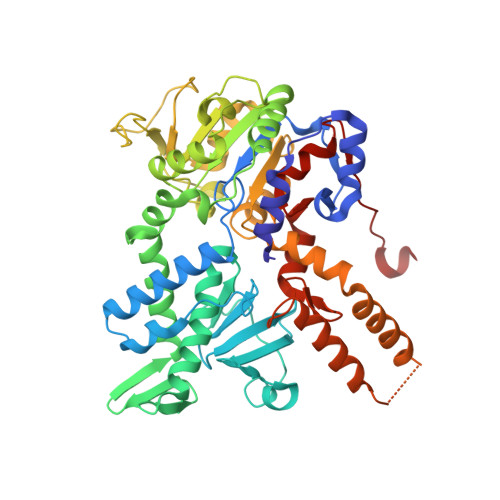Relapsed acute lymphoblastic leukemia-specific mutations in NT5C2 cluster into hotspots driving intersubunit stimulation.
Hnizda, A., Fabry, M., Moriyama, T., Pachl, P., Kugler, M., Brinsa, V., Ascher, D.B., Carroll, W.L., Novak, P., Zaliova, M., Trka, J., Rezacova, P., Yang, J.J., Veverka, V.(2018) Leukemia 32: 1393-1403
- PubMed: 29535428
- DOI: https://doi.org/10.1038/s41375-018-0073-5
- Primary Citation of Related Structures:
5OPK, 5OPL, 5OPM, 5OPN, 5OPO, 5OPP - PubMed Abstract:
Activating mutations in NT5C2, a gene encoding cytosolic purine 5'-nucleotidase (cN-II), confer chemoresistance in relapsed acute lymphoblastic leukemia. Here we show that all mutants became independent of allosteric effects of ATP and thus constitutively active. Structural mapping of mutations described in patients demonstrates that 90% of leukemia-specific allelles directly affect two regulatory hotspots within the cN-II molecule-the helix A region: residues 355-365, and the intersubunit interface: helix B (232-242) and flexible interhelical loop L (400-418). Furthermore, analysis of hetero-oligomeric complexes combining wild-type (WT) and mutant subunits showed that the activation is transmitted from the mutated to the WT subunit. This intersubunit interaction forms structural basis of hyperactive NT5C2 in drug-resistant leukemia in which heterozygous NT5C2 mutation gave rise to hetero-tetramer mutant and WT proteins. This enabled us to define criteria to aid the prediction of NT5C2 drug resistance mutations in leukemia.
Organizational Affiliation:
Institute of Organic Chemistry and Biochemistry, Academy of Sciences of the Czech Republic, Flemingovo nam. 2, Prague 6, 166 10, Czech Republic. [email protected].

















